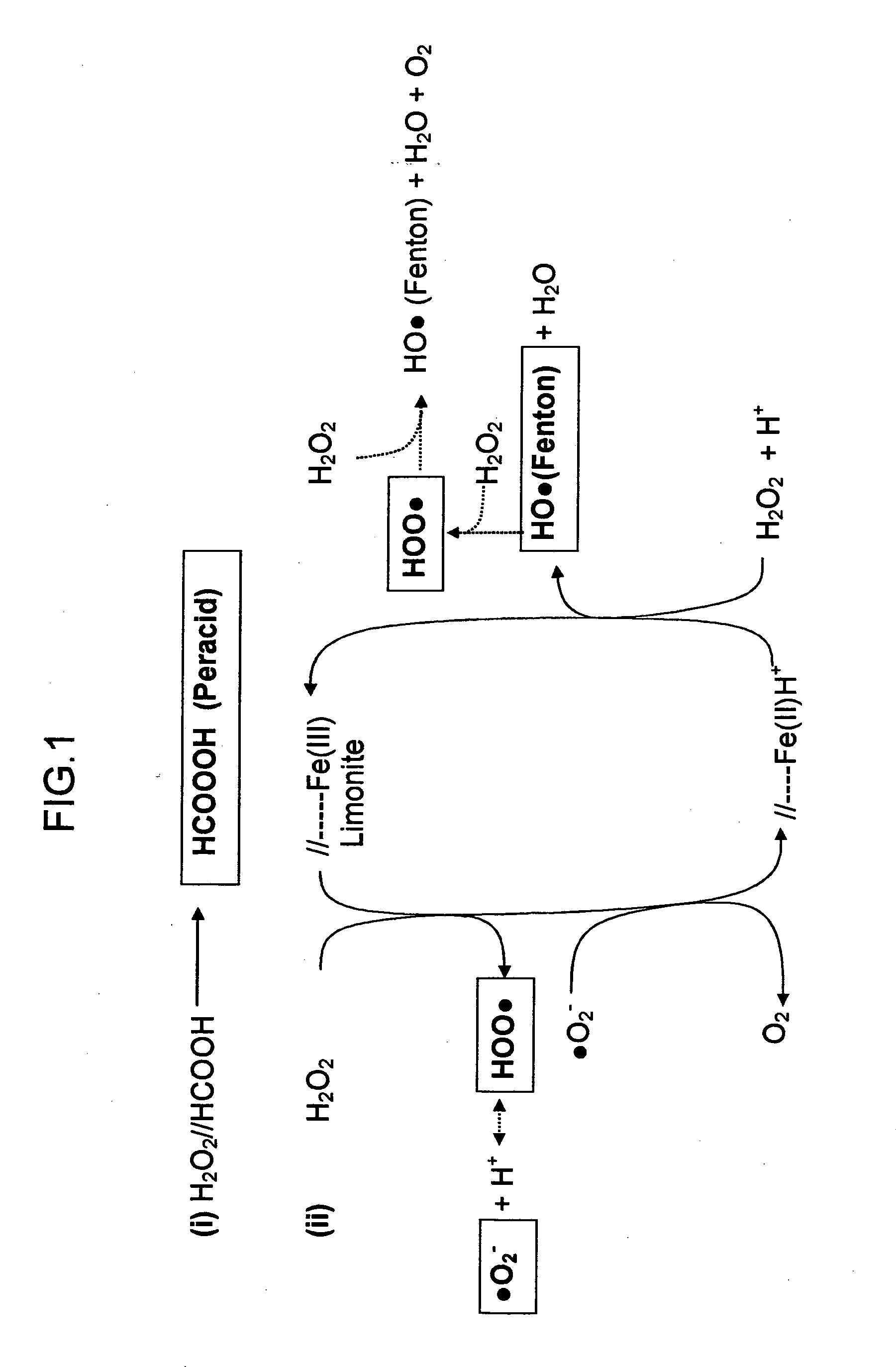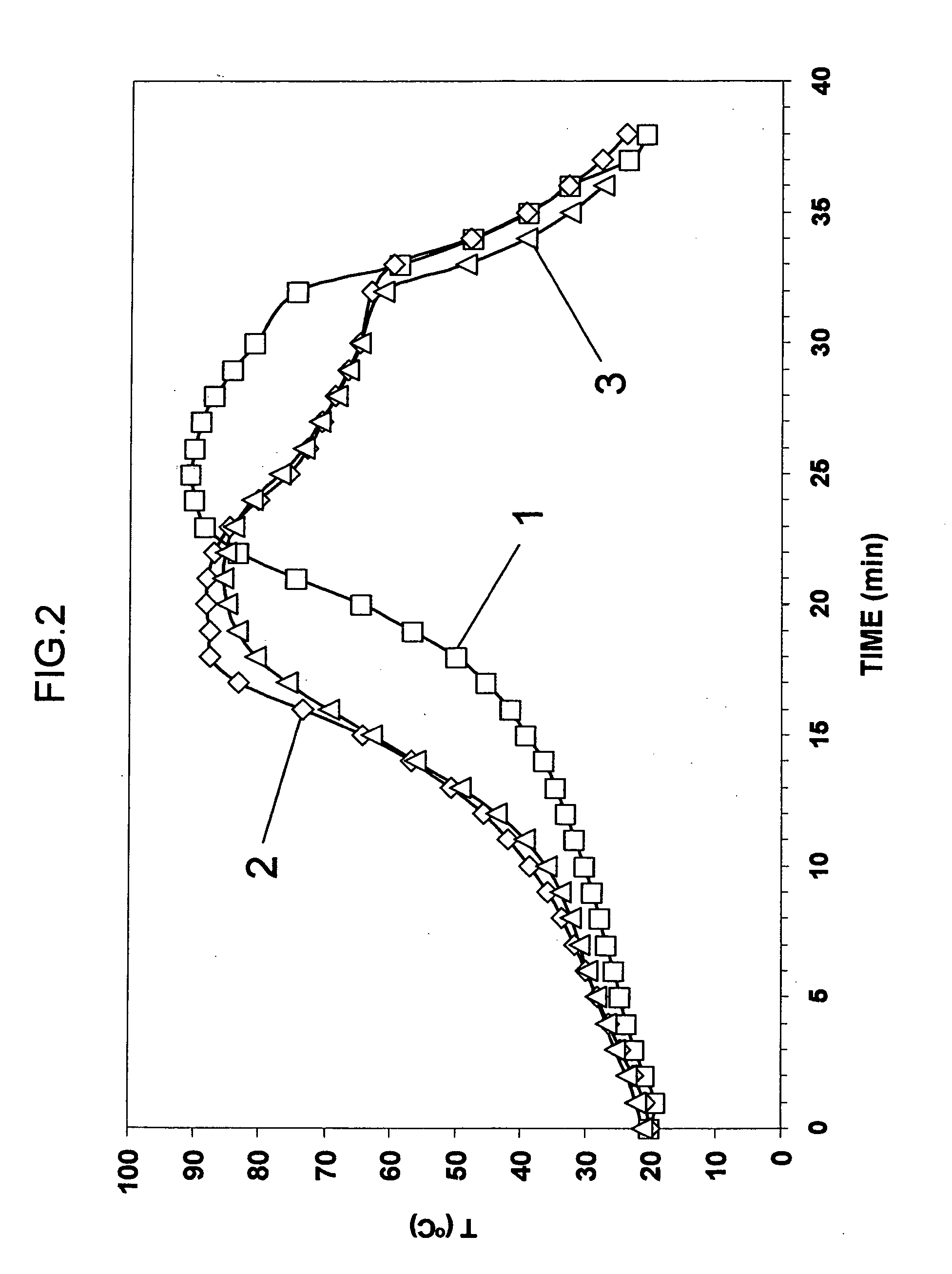Process for the extractive oxidation of contaminants from raw fuel streams catalyzed by iron oxides
a technology of raw fuel and iron oxide, applied in the field of extraction processes, can solve the problems of naphtha instability, harmful basic nitrogen compounds to the hydrodesulfurization process used in the naphtha finishing process, and excessive ph reduction
- Summary
- Abstract
- Description
- Claims
- Application Information
AI Technical Summary
Benefits of technology
Problems solved by technology
Method used
Image
Examples
example 1
[0071] This Example illustrates the extractive oxidation procedure as taught in the state-of-the-art technique, published US application US 2004 / 0108252. A petroleum-related feed is used.
[0072] To a 1-L capacity, round-bottomed three-way flask provided with a reflux condenser filled with glass beads and cooled at −10° C. with ethyl alcohol, to which is attached a dry ice trap to scavenge any hydrocarbon non-condensed in the reflux or entrained by non-condensable gases is added the oxidizing solution made up of 40 ml H2O2 (50% w / w) and 32 ml formic acid (85% w / w), previously mixed during 10 minutes agitation.
[0073] To the same flask are added 500 mL naphtha from the delayed coking of Marlim crude residue of distillation range from 37° C. to 190° C, density @20 / 4 0.748, containing 3,480 ppm total sulfur and 360 ppm total Nitrogen. The mixture is vigorously agitated for 2 minutes and then is added 1 g catalyst made up of 100% limonite ore (45 wt % Fe, from nickel mines of Central Bra...
example 2
[0078] This Example illustrates the procedure according to the invention, using the reduced iron oxide catalyst. The feed is the same petroleum-related feed of Example 1.
[0079] To a 1-L capacity, round-bottomed three-way flask provided with a reflux condenser filled with glass beads and cooled at −10° C. with ethyl alcohol, to which is attached a dry ice trap to scavenge any hydrocarbon non-condensed in the reflux or entrained by non-condensable gases is added the oxidizing solution made up of 40 ml H2O2 (50% w / w) and 32 ml formic acid (85% w / w), previously mixed during 10 minutes agitation.
[0080] To the same flask are added 500 mL naphtha from the delayed coking of Marlim crude residue of distillation range from 37° C. to 190° C., density @20 / 4 0.748, containing 3,480 ppm total sulfur and 360 ppm total Nitrogen. The mixture is vigorously agitated for 2 minutes and then is added 1 g catalyst limonite ore hydrogenated according to the following procedure.
[0081] Ten grams of limoni...
example 3
[0086] This Example illustrates another procedure according to the state-of-the-art technique as applied to a feed from shale retorting.
[0087] To a 1-L capacity, round-bottomed three-way flask provided with a reflux condenser filled with glass beads and cooled at −10° C. with ethyl alcohol, to which is attached a dry ice trap to scavenge any hydrocarbon non-condensed in the reflux or entrained by non-condensable gases is added the oxidizing solution made up of 40 ml H2O2 (50% w / w) and 32 ml formic acid (85% w / w), previously mixed during 10 minutes agitation.
[0088] To the same flask are added 500 mL of naphtha from the retorting of oil shale containing 12,229.3 ppm total Sulfur and 2,570.2 ppm total Nitrogen.
[0089] The mixture is vigorously agitated for 2 minutes and then is added 1 g catalyst made up of 100% limonite ore (45 wt % Fe, from nickel mines of Central Brazil) pulverized to less than 0.149 mm (−100 mesh Tyler) and oven-dried for 1 hour at 150° C. The reaction mixture is...
PUM
| Property | Measurement | Unit |
|---|---|---|
| temperatures | aaaaa | aaaaa |
| temperature | aaaaa | aaaaa |
| temperature | aaaaa | aaaaa |
Abstract
Description
Claims
Application Information
 Login to View More
Login to View More - R&D
- Intellectual Property
- Life Sciences
- Materials
- Tech Scout
- Unparalleled Data Quality
- Higher Quality Content
- 60% Fewer Hallucinations
Browse by: Latest US Patents, China's latest patents, Technical Efficacy Thesaurus, Application Domain, Technology Topic, Popular Technical Reports.
© 2025 PatSnap. All rights reserved.Legal|Privacy policy|Modern Slavery Act Transparency Statement|Sitemap|About US| Contact US: help@patsnap.com



